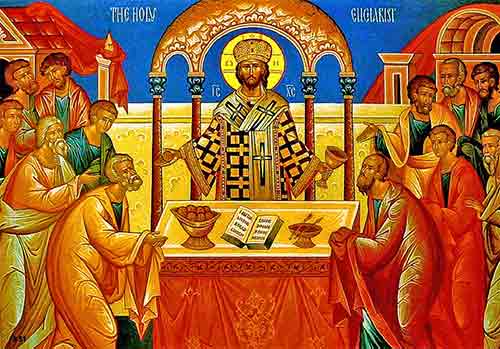
This post follows my reflection on the Eucharistic Prayer starting page 420 in A New Zealand Prayer Book He Karakia Mihinare o Aotearoa, and a further reflection on the Eucharistic Prayer starting page 436.
In reflecting on the quality of a Eucharistic Prayer (a Great Thanksgiving), here are some of the things I’m looking out for:
- Clearly a prayer of thanksgiving – consecrating by the community giving thanks (led by the gathered community’s presider) for the great acts of God
- following the Jewish Berakah structure (Praise – Proclaim – Petition – Praise)
- Easily-remembered, consistent responses and acclamations (so preferably poetic and singable) for the gathered community so that they are not focusing on a book (or a projector screen)
- Inclusive and expansive language
- A prayer that flows well, keeps to a consistent tone, and has a broad enough theology to cover acceptable interpretations
Let’s look at another Eucharistic Prayer authorised or allowed in the Anglican Church in Aotearoa, New Zealand and Polynesia.
Thanksgiving for Creation and Redemption (P. 467)
Like the Eucharistic Prayer from p436 (and unlike the prayer beginning p420), this prayer is primarily the work of one person, in this case, Rev. Dr. Raymond Pelly. Having said that, it needed acceptance by the whole Prayer Book committee, and then, of course, being passed by the twice-round process to make it a formulary of our Church (General Synod – episcopal units – back to General Synod…)
Its history is clearly explained here (especially from page 58 onwards). From 1977, there was a growing appreciation of inclusive language. From 1978, there was a strong movement to have significant verbal differences between options. In Auckland, some had been working on revisions of the 1970 communion rite. For the 1984 communion booklet, this prayer was essentially one of two options to a significantly different rite.
From my thesis p112 onwards, you can see the evolution of this prayer from essentially having the same responses, as the first two prayers we looked at have, to how we know it today.
Lift your hearts to heaven
where Christ in glory reigns.
This only became a new response between 1984 and 1988.
Sursum corda (“Lift up Your hearts…”) has been there from our earliest Christian liturgies. This also means that it is present across the different Christian denominations – Orthodox and Western. This new response, Lifting our hearts to heaven, to a place where we say Christ in glory reigns, comes across as escapism from this physical world and encouraging an unhelpful dualism. Initially, this was presented as the response for all Eucharistic Prayers at the 1987 meeting of General Synod. But that General Synod built on the concept of different responses for different rites, and for Prayers 1 and 2, reverted to the traditional, ecumenical form.
The shared Sursum corda (Lift up your hearts. We lift them to the Lord.) is restored in the revised version called, Alternative Great Thanksgiving C.
In Thanksgiving for Creation and Redemption, there are congregational responses within the Preface. [These are removed in the revised version].
As with the previous two prayers, the first “Therefore” is still reducing our response to God’s actions to saying (or singing) words in:
Therefore with saints and martyrs,
apostles and prophets,
with all the redeemed,
joyfully we praise you and say
As you can see (my thesis page 114), attempts at making the Benedictus inclusive were abandoned in 1983 and a completely different acclamation replaced the Sanctus/Benedictus. It is easier to get people to accept a totally different acclamation than to have them adapt to tinkering with a well-loved, well-known traditional one.
The traditional Sanctus/Benedictus (without an option to omit the Benedictus) is restored in the revision.
Christ’s blood shed “for many” (rather than “for all”) is retained, as is NZ’s eccentric “to remember me”.
The acclamation, “Amen! Come Lord Jesus.” divides the Proclaim from the Petition section.
The epiclesis is relatively weak:
Empower our celebration with your Holy Spirit,
feed us with your life,
fire us with your love,
confront us with your justice,
and make us one in the body of Christ
with all who share your gifts of love.
When this was separated from the other Eucharistic Prayer into a whole Thanksgiving for Creation and Redemption rite, “Creator” was pasted into places to give it more of a Creation feel.
“Lord” is present once in the presider’s solo parts (ie. outside of the agreed responses and acclamations). “Father” is absent in the revision – it occurs once in the original (“our access to you, Father”). “Son” is also absent.


